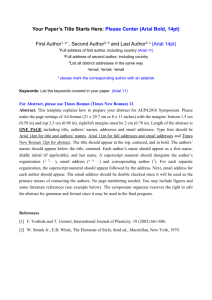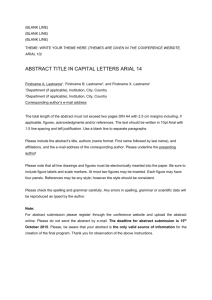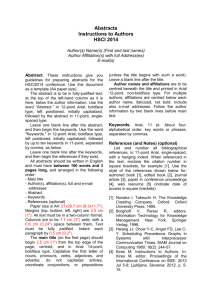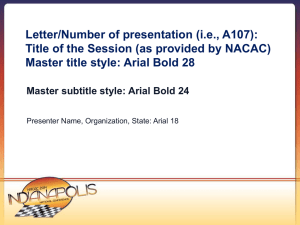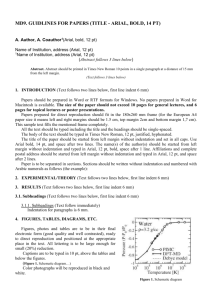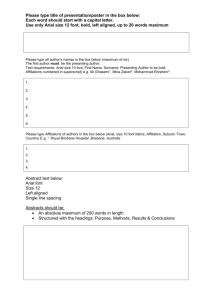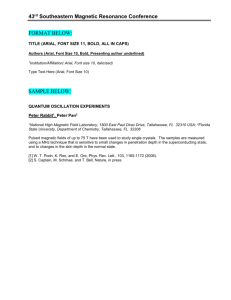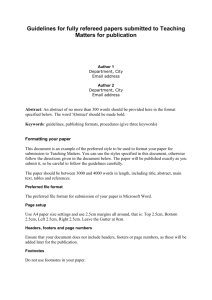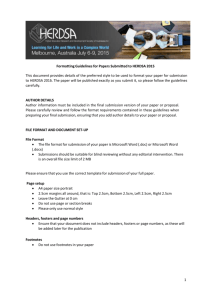Guidelines for Authors
advertisement
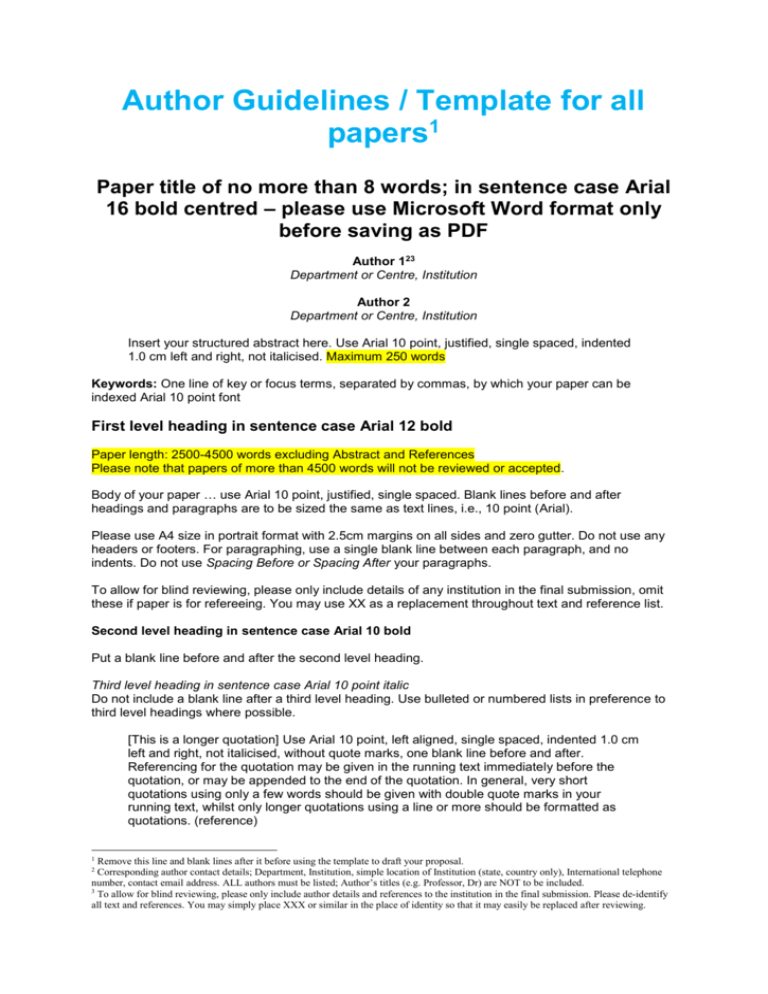
Author Guidelines / Template for all papers1 Paper title of no more than 8 words; in sentence case Arial 16 bold centred – please use Microsoft Word format only before saving as PDF Author 123 Department or Centre, Institution Author 2 Department or Centre, Institution Insert your structured abstract here. Use Arial 10 point, justified, single spaced, indented 1.0 cm left and right, not italicised. Maximum 250 words Keywords: One line of key or focus terms, separated by commas, by which your paper can be indexed Arial 10 point font First level heading in sentence case Arial 12 bold Paper length: 2500-4500 words excluding Abstract and References Please note that papers of more than 4500 words will not be reviewed or accepted. Body of your paper … use Arial 10 point, justified, single spaced. Blank lines before and after headings and paragraphs are to be sized the same as text lines, i.e., 10 point (Arial). Please use A4 size in portrait format with 2.5cm margins on all sides and zero gutter. Do not use any headers or footers. For paragraphing, use a single blank line between each paragraph, and no indents. Do not use Spacing Before or Spacing After your paragraphs. To allow for blind reviewing, please only include details of any institution in the final submission, omit these if paper is for refereeing. You may use XX as a replacement throughout text and reference list. Second level heading in sentence case Arial 10 bold Put a blank line before and after the second level heading. Third level heading in sentence case Arial 10 point italic Do not include a blank line after a third level heading. Use bulleted or numbered lists in preference to third level headings where possible. [This is a longer quotation] Use Arial 10 point, left aligned, single spaced, indented 1.0 cm left and right, not italicised, without quote marks, one blank line before and after. Referencing for the quotation may be given in the running text immediately before the quotation, or may be appended to the end of the quotation. In general, very short quotations using only a few words should be given with double quote marks in your running text, whilst only longer quotations using a line or more should be formatted as quotations. (reference) 1 Remove this line and blank lines after it before using the template to draft your proposal. Corresponding author contact details; Department, Institution, simple location of Institution (state, country only), International telephone number, contact email address. ALL authors must be listed; Author’s titles (e.g. Professor, Dr) are NOT to be included. 3 To allow for blind reviewing, please only include author details and references to the institution in the final submission. Please de-identify all text and references. You may simply place XXX or similar in the place of identity so that it may easily be replaced after reviewing. 2 Do not use page breaks or sections breaks. Where necessary or desirable, use several carriage returns to obtain a page break. Bullet lists should be round bullet type for level 1 Left indent to 0.5cm with hanging indent of 0.5cm - Use dash bullet type for level 2 - Left indent to 1.5cm with hanging indent of 0.5cm 1. Use numerals followed by full stop for ordered list 2. Left indent to 0.5cm with hanging indent of 0.5cm a. For level 2 use lowercase letter followed by full stop b. Left indent to 1.5cm with hanging indent of 0.5cm Figure 1: Sample of a figure (legend is below figure, centred, bold) Figures must be placed in their correct location in your running text. All figures should be included in your Word file, and not in separate graphic or drawing package format. Labelling should be consistent with the fonts used in the text of your paper, i.e., Arial. Number sequentially, Figure 1, Figure 2, etc. Do not use variations such as Figure 1a, 1b. Table 1: A sample table (title is above table, centred, bold) Location General Format Explanatory text Tables must be placed in their correct, appropriate locations in your running text In general use Arial 10 point and other body text specifications for all text within a table and its title, though 9 point may be used as required for narrow columns. Tables should have a title with consecutive numbering (e.g.: Table 1: Title of the table), bolded, using sentence case, centred, and located at the top of the table. For headings within tables use sentence case, with bold and centring optional. Centre each table and select appropriate widths for the table and for each column, using percentages. Use of borders for all cells (‘All’, with style ‘1/4 point’) is recommended, mainly because borders seem to be helpful for on screen reading. In columns of numbers, use centre or decimal point alignment. If your table requires explanatory text that is inappropriate for placing in your running text, place it at the bottom of the table, formatted to the same width as the table. Acknowledgments Authors can make appropriate acknowledgments just prior to the reference list. Authors must declare all sources of external research funding in their article and a statement to this effect should appear in the Acknowledgements section. Authors should describe the role of the funder or financial sponsor in the entire research process, from study design to submission. To allow for blind reviewing, please only include details in the final submission, omit these if paper is for refereeing. References Use APA 6th edition style for references. Publications should be cited in the text using the first author's surname (Adams, 2006) if one author. For two authors, cite with surnames of both authors (Adams & Brown, 2006). When a reference has 3, 4 or 5 authors, cite all authors the first time the reference occurs, but in subsequent citations, include only the surname of the first author followed by et al. (e.g. Adams et al., 2006). Only when a work has 6 or more authors do you use et al. the first time the reference is cited. At the end of the paper a reference list in alphabetical order by first author should be supplied. Use Arial 10 point, left aligned, hanging indent 0.5 cm, with no blank lines. Wherever possible, insert doi and URLs for references. However, do not insert URLs for publications that only offer pay per view, institutional subscriber, or on campus only access to full text. The date of viewing may be omitted for journal and proceedings URLs considered to be of high reliability. The following list provides examples of referencing for the main kinds of publications. However, do not group references in submissions: Journal Article Stephens, J. C., Hernandez, M. E., Román, M., Graham, A. C., & Scholz, R. W. (2008). Higher education as a change agent for sustainability in different cultures and contexts. International Journal of Sustainability in Higher Education, 9(3), 317-338. doi: 10.1108/14676370810885916 Conference Paper Presentation Cooper, T., & Scott, R. H. (2010). Sustainability, survival and engagement: Implications for curriculum and pedagogy in social professions. Educating for sustainability. Proceedings of the 19th Annual Teaching Learning Forum, 28-29 January 2010. Perth, Western Australia: Edith Cowan University. http://otl.curtin.edu.au/tlf/tlf2010/contents-all.html Conference Proceedings Pickles, T. (1993). Value and quality of industrial placements: Students’ views. In R. J. A. Bradley & A. N. Glynn (Eds.), Proceedings of the Eighth World Conference on Cooperative Education (pp. 209212). Dublin, Ireland: World Association for Cooperative Education. Chapter in a Book Scott, R. H. (2007). Evaluating a professional learning in Shark Bay, Western Australia. In D. B. Zandvliet & D. L. Fisher (Eds.), Sustainable Communities, Sustainable Environments (pp. 131141). Rotterdam, Netherlands: Sense. Book Dee, J. (2010). Sustainable growth: Small business, big opportunity. Melbourne, VIC, Australia: Sensis.
